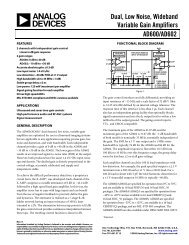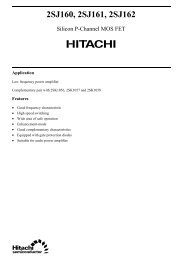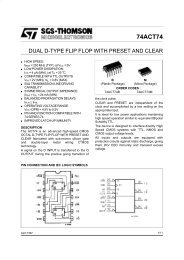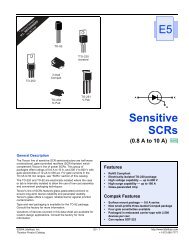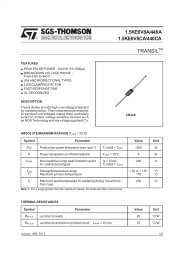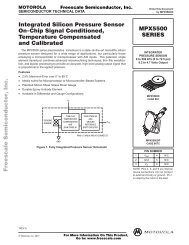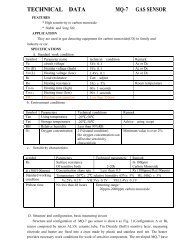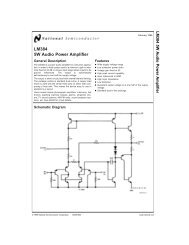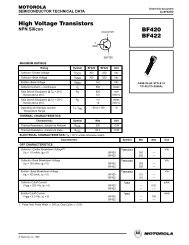TMS320F206 Digital Signal Processor (Rev. A) - Futurlec
TMS320F206 Digital Signal Processor (Rev. A) - Futurlec
TMS320F206 Digital Signal Processor (Rev. A) - Futurlec
You also want an ePaper? Increase the reach of your titles
YUMPU automatically turns print PDFs into web optimized ePapers that Google loves.
<strong>TMS320F206</strong>DIGITAL SIGNAL PROCESSORSPRS050A – NOVEMBER 1996 – REVISED APRIL 1998resetThe <strong>TMS320F206</strong> utilizes an active-low reset (RS) input.A minimum pulse duration of six cycles ensures that an asynchronous reset signal resets the device properly.The <strong>TMS320F206</strong> fetches its first instruction approximately sixteen cycles after the rising edge of RS.The reset action halts all operations whether they are completed or not; therefore, the state of the system andits data cannot be maintained through the reset operation. For example, if the device is writing to an externalresource when the reset is initiated, the write is aborted; this may corrupt the contents or configuration of systemresources. Therefore, it is necessary to reinitialize the system after a reset.power-down modesThe ’F206 implements a power-down mode in which the ’F206 core enters a dormant state and dissipates lesspower. The power-down mode is invoked by executing an IDLE instruction. While the device is in power-downmode, the on-chip peripherals continue to operate.While the ’F206 is in a power-down mode, all of its internal contents are maintained; this allows operation tocontinue unaltered when the power-down mode is terminated. All CPU activities are halted when the IDLEinstruction is executed, but the CLKOUT1 pin remains active depending on the status of ICR register. Theperipheral circuits continue to operate, allowing peripherals such as serial ports and timers to take the CPU outof its powered-down state. The power-down mode, when initiated by an IDLE instruction, is terminated uponreceipt of an interrupt.software-controlled wait-state generatorDue to the fast cycle time of the <strong>TMS320F206</strong> devices, it is often necessary to operate with wait states tointerface with external logic or memory. For many systems, one wait state is adequate.The software wait-state generator can be programmed to generate between 0 and 7 wait states for a givenspace. Software wait states are configured by way of the wait-state generator register (WSGR). The WSGRincludes four 3-bit fields to configure wait states for the following external memory spaces: data space (DSWS),upper program space (PSUWS), lower program space (PSLWS), and I/O space (ISWS). The wait-stategenerator enables wait states for a given memory space based on the value of the corresponding three bits,regardless of the condition of the READY signal. The READY signal can be used to generate additional waitstates. All bits of the WSGR are set to 1 at reset so that the device can operate from slow memory from reset.The WSGR register (shown in Table 9, Table 10 and Table 11) resides at I/O port 0xFFFCh.Table 9. Wait-State Generator Control Register (WSGR)15 14 13 12 11 10 9 8 7 6 5 4 3 2 1 0Reserved ISWS DSWS PSUWS PSLWS0 R/W–111 R/W–111 R/W–111 R/W–111LEGEND:0 = Always read as zeros, R = Read Access, W= Write Access, – n = Value after reset22 POST OFFICE BOX 1443 • HOUSTON, TEXAS 77251–1443



